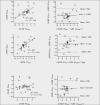Measurement of body composition changes with weight loss in postmenopausal women: comparison of methods
- PMID: 17508096
- PMCID: PMC2495082
Measurement of body composition changes with weight loss in postmenopausal women: comparison of methods
Abstract
Background: The accurate measurement of body composition changes is important when evaluating the efficacy of medical nutrition therapy and weight management programs, yet is not well documented in older women.
Objective: We compared methods of estimating energy-restriction-induced body composition changes in postmenopausal women.
Design: 27 women (59 +/- 8 y; BMI 29.0 +/- 2.9 kg/m2; mean +/- SD) completed a 9-wk energy restriction period (5233 kJ/d, (1250 kcal/d)). Changes in % body fat (delta%BF), fat mass (deltaFM), and fatfree mass (deltaFFM) were measured by hydrostatic weighing (HW), air-displacement plethysmography (ADP), dual-energy x-ray absorptiometry (DXA), and deuterium oxide dilution (D2O). The Baumgartner et al. (Am J Clin Nutr 53:1345-1353, 1991) four-compartment (4C) model with body volume from HW was the criterion method. The 4C model with body volume from ADP was also compared. Regression equations were developed based on 4CHW (dependent variable) utilizing results of change (POST-PRE) for each method.
Results: The women lost 6.8 +/- 3.2 kg; 9% of baseline weight. Based on 4CHW, the body composition changes were -2.4 +/- 4.5 delta%BF, -4.7 +/- 3.3 kg deltaFM, and -2.6 +/- 4.4 kg deltaFFM. No differences were detected by ANOVA for delta%BF, deltaFM, and deltaFFM among 4CHW, HW, ADP, DXA, D2O, and 4CADP. Bland-Altman limits of agreement showed differences between methods that ranged from 14.5 to -14.1 delta%BF, 7.8 to -8.1 kg deltaFM, and 7.5 to -8.4 kg deltaFFM for individuals. A bias was shown with 4CADP overestimating delta%BF (1.4 %) and FM (0.6 kg) and underestimating deltaFFM (-1.2 kg) compared to 4CHW. The regression model was acceptable for %BF (4CADP, 2CHW, and 2CD2O); FM and FFM (4CADP, 3CDXA, 2CHW, and 2CD2O), but not for other estimates of %BF, FM, FFM.
Conclusions: These body composition assessment methods may be used interchangeably to quantify changes in % body fat, fat mass, and fat-free mass with weight loss in groups of postmenopausal women. 4CADP overestimates delta%BF and underestimates deltaFFM. When utilizing one of these comparison methods (4CADP, 3CDXA, 2CHW, 2CD2O) to quantify changes in fat mass and fat-free mass for an individual postmenopausal woman, regression equations may be used to relate the data to 4CHW.
Figures


Similar articles
-
Comparison of multiple methods to measure maternal fat mass in late gestation.Am J Clin Nutr. 2016 Apr;103(4):1055-63. doi: 10.3945/ajcn.115.113464. Epub 2016 Feb 17. Am J Clin Nutr. 2016. PMID: 26888714 Free PMC article.
-
Changes in thoracic gas volume with air-displacement plethysmography after a weight loss program in overweight and obese women.Eur J Clin Nutr. 2008 Mar;62(3):444-50. doi: 10.1038/sj.ejcn.1602709. Epub 2007 Mar 28. Eur J Clin Nutr. 2008. PMID: 17392701
-
Influence of methods used in body composition analysis on the prediction of resting energy expenditure.Eur J Clin Nutr. 2007 May;61(5):582-9. doi: 10.1038/sj.ejcn.1602556. Epub 2006 Nov 29. Eur J Clin Nutr. 2007. PMID: 17136038
-
Body fat gain and loss differentially influence validity of dual-energy x-ray absorptiometry and multifrequency bioelectrical impedance analysis during simultaneous fat-free mass accretion.Nutr Res. 2020 Mar;75:44-55. doi: 10.1016/j.nutres.2019.12.006. Epub 2019 Dec 12. Nutr Res. 2020. PMID: 31962277
-
Body-composition assessment via air-displacement plethysmography in adults and children: a review.Am J Clin Nutr. 2002 Mar;75(3):453-67. doi: 10.1093/ajcn/75.3.453. Am J Clin Nutr. 2002. PMID: 11864850 Review.
Cited by
-
Effects of caloric restriction with different doses of exercise on fat loss in people living with type 2 diabetes: A secondary analysis of the DOSE-EX randomized clinical trial.J Sport Health Sci. 2024 Oct 18;14:100999. doi: 10.1016/j.jshs.2024.100999. Online ahead of print. J Sport Health Sci. 2024. PMID: 39427878 Free PMC article.
-
Accuracy of DXA in estimating body composition changes in elite athletes using a four compartment model as the reference method.Nutr Metab (Lond). 2010 Mar 22;7:22. doi: 10.1186/1743-7075-7-22. Nutr Metab (Lond). 2010. PMID: 20307312 Free PMC article.
-
Resistance training preserves fat-free mass without impacting changes in protein metabolism after weight loss in older women.Obesity (Silver Spring). 2009 Jul;17(7):1332-9. doi: 10.1038/oby.2009.2. Epub 2009 Feb 26. Obesity (Silver Spring). 2009. PMID: 19247271 Free PMC article. Clinical Trial.
-
The Efficacy of Zinc Gluconate Supplementation in the Improvement of Malnutrition Indices and Skin Abnormalities in Hemodialysis Patients: A Randomized Clinical Trial.Int J Prev Med. 2024 Nov 28;15:63. doi: 10.4103/ijpvm.ijpvm_206_23. eCollection 2024. Int J Prev Med. 2024. PMID: 39742128 Free PMC article.
-
Effects of dietary protein intake on body composition changes after weight loss in older adults: a systematic review and meta-analysis.Nutr Rev. 2016 Mar;74(3):210-24. doi: 10.1093/nutrit/nuv065. Epub 2016 Feb 16. Nutr Rev. 2016. PMID: 26883880 Free PMC article.
References
-
- Heymsfield SB, Wang ZM. Measurement of total-body fat by underwater weighing: new insights and uses for old method. Nutrition. 1993;9:472–3. - PubMed
-
- McCrory MA, Gomez TD, Bernauer EM, Mole PA. Evaluation of a new air displacement plethysmograph for measuring human body composition. Med Sci Sports Exerc. 1995;27:1686–91. - PubMed
-
- Roubenoff R, Kehayias JJ, Dawson-Hughes B, Heymsfield SB. Use of dual-energy x-ray absorptiometry in body-composition studies: not yet a ”gold standard”. Am J Clin Nutr. 1993;58:589–91. - PubMed
-
- Brozek J, Grande F, Anderson JT, Keys A. Densitometric Analysis of Body Composition: Revision of Some Quantitative Assumptions. Ann N Y Acad Sci. 1963;110:113–40. - PubMed
-
- Fogelholm GM, Sievanen HT, Lichtenbelt WDVM, Westerterp KR. Assessment of Fat-mass loss during weight reduction in obese women. Metabolism. 1997;46:968–975. - PubMed
Publication types
MeSH terms
Grants and funding
LinkOut - more resources
Full Text Sources
Medical
Miscellaneous
